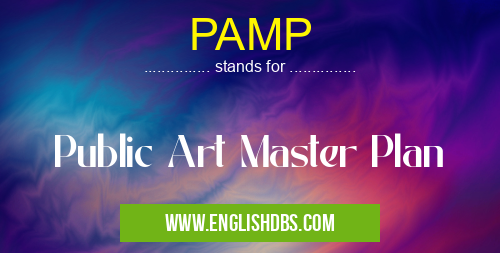What does PAMP mean in ART
PAMP stands for Public Art Master Plan. It is a comprehensive document that outlines a city or town's vision, goals, and strategies for public art. A PAMP typically includes an inventory of existing public art, an analysis of the community's needs and desires, and a plan for future public art projects.

PAMP meaning in Art in Community
PAMP mostly used in an acronym Art in Category Community that means Public Art Master Plan
Shorthand: PAMP,
Full Form: Public Art Master Plan
For more information of "Public Art Master Plan", see the section below.
PAMP's Meaning in COMMUNITY
Public art plays a vital role in creating a sense of place and community. It can beautify public spaces, stimulate economic development, and promote social cohesion. A well-developed PAMP can help to ensure that public art is integrated into the fabric of the community and that it reflects the unique character of the place.
PAMP Full Form
The full form of PAMP is Public Art Master Plan. It is a strategic document that provides a framework for the planning, development, and management of public art in a community.
What Does PAMP Stand for?
PAMP stands for Public Art Master Plan. It is a comprehensive plan that outlines a city or town's goals, strategies, and priorities for public art.
Essential Questions and Answers on Public Art Master Plan in "COMMUNITY»ART"
What is the purpose of a Public Art Master Plan (PAMP)?
A PAMP establishes a comprehensive framework for the development, acquisition, and management of public art within a defined geographic area. It guides the creation and integration of public art into the built environment, enhancing public spaces and promoting community identity.
What are the key components of a PAMP?
A PAMP typically includes an inventory of existing public art, guidelines for new art commissions, strategies for public engagement, funding mechanisms, and a framework for ongoing management and evaluation.
Who develops and implements a PAMP?
PAMPs are typically developed by local governments, in collaboration with artists, community representatives, and other stakeholders. A designated agency or department is responsible for implementing the plan and overseeing its ongoing maintenance.
What are the benefits of having a PAMP?
A PAMP can enhance the aesthetic appeal of public spaces, foster community pride, promote cultural expression, attract tourism, and support local artists. It also ensures a consistent and transparent approach to public art decision-making.
How can the public participate in the development of a PAMP?
Public engagement is a crucial part of PAMP development. Communities should be given opportunities to provide input through surveys, workshops, public meetings, and online platforms. Open and inclusive participation ensures that the plan reflects the needs and aspirations of the community.
Final Words: A PAMP is an essential tool for communities that are committed to using public art to create a more vibrant and engaging place to live. By providing a clear vision and a roadmap for future development, a PAMP can help to ensure that public art is an integral part of the community's identity and culture.
